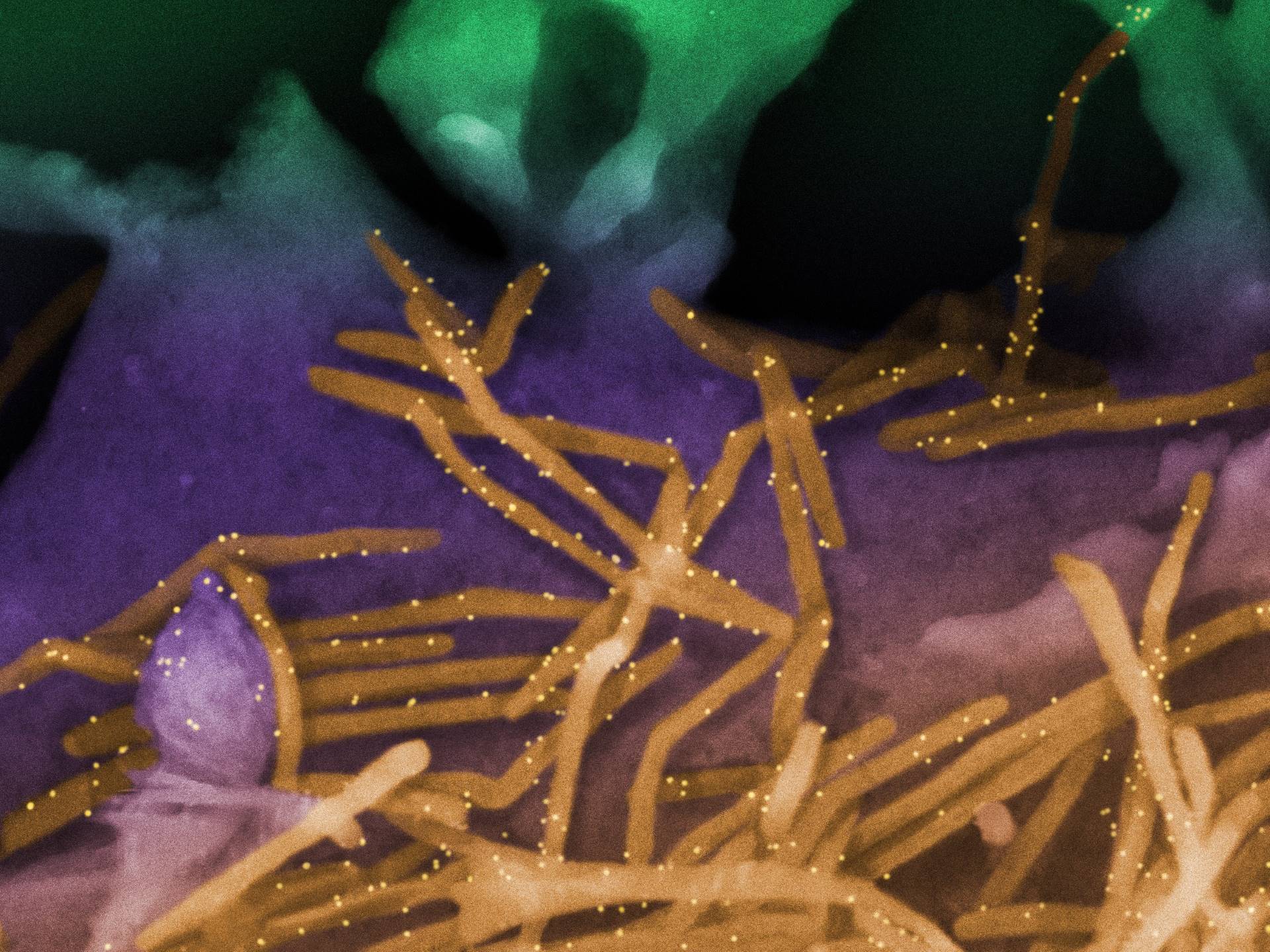The Lamen
RSV — Respiratory Syncytial Virus Infection, Explained

Scanning electron micrograph of human respiratory syncytial virus (RSV), colorized in Halloween-appropriate colors. Virions (colorized gold) are labeled with anti-RSV F protein/gold antibodies (colorized yellow) shedding from the surface of human lung epithelial A549 cells.
Photo: NIAID/Flickr
Respiratory syncytial virus is a common pathogen that causes infection of the lungs and respiratory tract — more common in children than in adults.
In this article
The infection is so common that nearly all children have had it by the age of 2. In most cases, the virus causes mild cold- or flu-like symptoms such as a runny nose, mild fever, or a sore throat.
However, the infection can be dangerous in some infants and children — with an estimated 58,000-80,000 children under the age of 5 being hospitalized due to a serious RSV infection every year. Such infections can cause more serious complications, like bronchiolitis and pneumonia.
What causes RSV, and how does it spread?
The respiratory syncytial virus is a common winter virus that can enter the body through the eyes, nose, or mouth — and can spread from person to person.
RSV is typically transmitted by:
- breathing in infectious droplets when a person with the virus coughs or sneezes
- getting the viral droplets into your eyes, nose, or mouth
- having direct contact by, for instance, kissing the face of a child with RSV
- having indirect contact by touching a surface or object that an infected person has come in contact with, and then touching your face
People infected with RSV are contagious for 3 to 8 days, typically becoming contagious a day or two before showing symptoms. You can also get infected more than once.
Symptoms and Complications
Symptoms of RSV typically appear within 4 to 6 days, with most mild infections lasting a week or two. It is an infection of the respiratory tract.
Common symptoms of a mild infection include:
- congestion
- runny nose
- coughing
- sneezing
- headache
- fever
Severe symptoms in infants include:
- flaring of nostrils when breathing
- lips, mouth, and fingernails turning blue or gray
- short, shallow, slow, or rapid breathing
- wheezing or severe cough
In addition, infants and toddlers can get fussy or irritable, experience a decreased appetite, and show changes in their breathing patterns.
Young children have a more difficult time coping with the infection since their immune systems are still developing, and congestion can cause them to grow irritable.
Who is at risk of a more serious RSV infection?
People at an increased risk of severe RSV infections include:
- premature infants or infants up to 12 months old
- children or adults with a compromised immune system
- children with chronic lung disease or congenital heart disease
- adults with chronic lung or heart disease
- all older adults — especially those 65 years and older
It is also possible to get infected again and during the same season. Repeat infections can be more taxing on the immune system, and can cause a serious infection in infants, older adults, or people with chronic heart or lung disease.
Treatment and Prevention
RSV can be difficult to diagnose because the symptoms can be similar to other respiratory viruses, such as the flu and COVID-19. In case of a mild infection, however, lab tests are considered unnecessary.
Treatment: Mild RSV infections go away in a week or two without treatment, but supportive care can ease the symptoms.
- Your doctor may recommend over-the-counter medications to reduce fever (such as Tylenol), nasal saline drops, and pain relievers.
- Keeping a child hydrated and comfortable are the typical supportive care measures.
- In case of a serious infection, hospitalization may be required. This involved intravenous (IV) fluids, tube feeding, suction of mucus, and mechanical ventilation depending upon severity.
Prevention: RSV is highly contagious, and spreads when people touch contaminated surfaces or through respiratory droplets — making it tough to avoid. Disinfecting surfaces and avoiding close contact with others who are sick can help.
The CDC recommends two ways to protect children from severe RSV infections — a preventative antibody or a vaccination received during pregnancy. Adults 60 years or older are recommended to get an RSV vaccination.
RSV Vaccination
The Centers for Disease Control and Prevention recommends several different vaccines that protect children and older adults from severe infection.
- Adults aged 60 and older can receive a single dose of RSV vaccine using shared clinical decision-making.
- One dose of a preventive vaccine delivered during pregnancy during weeks 32-36.
- Infants and young children can receive one dose of nirsevimab when aged 8 months and younger born during or entering their first RSV season. Children aged 24 months and younger may instead get a different monoclonal antibody, palivizumab.
Any decisions made about vaccinations should first be discussed with your healthcare provider.